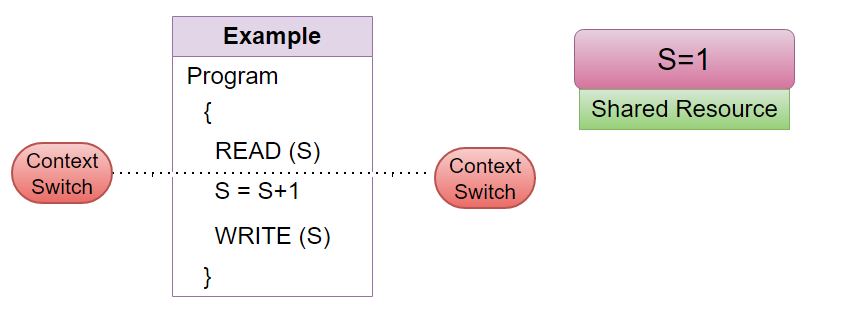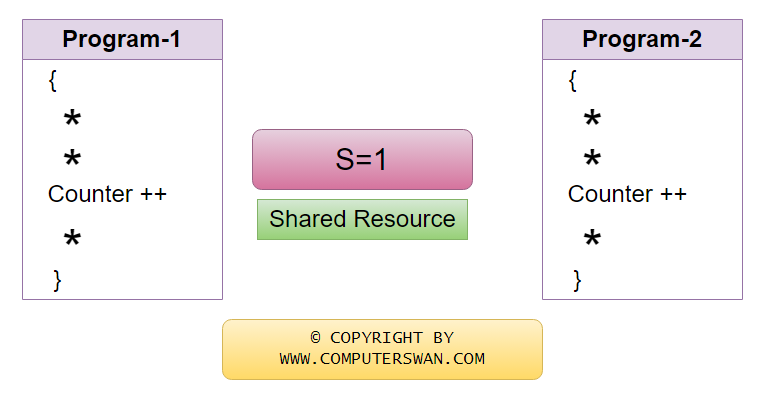Table of Contents
ToggleWhat is a Race Condition In OS :
A race condition in operating systems, often referred to as “race condition in OS,” occurs when a system attempts to execute two or more operations simultaneously, requiring a specific sequence for correct completion. This phenomenon, encapsulated in the term “Race Condition,” emerges when different processes or threads engage in concurrent activities, contrary to their intended sequence. The root of this issue lies in the neglect of proper ordering by programmers, leading to unpredictable behavior in applications.
Essentially, race conditions underscore the importance of maintaining the correct sequence in executing operations. In operating systems, the term is synonymous with the challenges associated with managing simultaneous tasks that demand a specific order for accurate execution. Mitigating race conditions involves addressing conflicts arising from parallel activities, emphasizing the significance of critical sections in programming to ensure orderly and error-free execution. Understanding and addressing race conditions are important for enhancing the reliability and stability of operating systems.
To understand race conditions in operating systems better, we’ll explore advanced examples in this article. These examples are closely tied to the actual design and development of an operating system, similar to what we’ve discussed so far. They’ll show how race conditions happen and affect the complex operations of a real operating system. Keep in mind that the next sections will take a detailed approach, providing insights that go beyond the usual teachings.
What are examples of race conditions?
Let’s consider we have a shared variable named ‘S,’ referred to as a ‘Shared Resource,’ with a value of 1.

Step 1- We have a simple program with three instruction phases:
- Phase One: Read Variable
- Phase Two: Increment Variable
- Phase Three: Write Value of Variable
PROGRAM()
{
READ (S)
S=S+1
WRITE (S)
}
Step 2- We have two processes, P1 and P2, intending to access our shared variable.
The systematic fashion order is as follows:
First P1 executes and reads the value of the shared variable ‘S,’ which is 1.
In the next phase, the variable is incremented by 1, making the value now 2.
In the subsequent phase, the value of the variable is written back to shared memory.
Now P2 executes, reads the updated value of the shared variable ‘S,’ which is now 2.
In the next phase, the variable is incremented by 1, making the value 3.
In the final phase, the updated value is written back to shared memory.
The result is = 3
Conclusion- Here, we observe that our shared resource is the same, but different processes access it systematically (P1 followed by P2). This ensures proper system behavior without any interference.
Problem (How Does Race Condition Occur) :

If we attempt to run both processes, P1 and P2, simultaneously, what will happen?
P1 Operation:
- P1 is executing and reads the value of the shared variable ‘S’ in Phase 1, which is 1.
- After that context switch occurs (because both processes are trying to access the shared resource ‘S‘ simultaneously).
- The data read by the previous process P1 from the context switch, which was 1, is saved, and it gets suspended.
- Due to above context switch Process P2 enters, executing Phase 2, incrementing the value by 1.
- So, the value of Process P2 becomes 2.
Now Another context switch occurs.
Now, P1 resumes from where the last context switch occurred:
- P1 starts with the same data where the last context switch happened, and its value was 1.
- In the next phase, the value increments to 2.
- In the final phase, the variable value is written to memory, resulting in 2.
Conclusion: Here, both processes have the same value, which should not be the case. This indicates a problem because they did not follow the systematic order, leading to a race condition where the execution order can change the result.
Result is = 2
Critical Section Problem in OS (Operating System) :
What is the critical section problem in operating systems?
In scenarios where resources are shared, it is crucial to ensure that only one process accesses the resource at a time. Although the resource is designed to be shared, it should be accessed by one process sequentially. The part of the program where we access the shared resource is referred to as the ‘Critical Section’.
Problem Solution:
To address this issue, implement a mechanism where only one process enters the critical section at a time, and other processes wait for its completion. This ensures that problems associated with simultaneous access to shared resources, known as race conditions, are avoided. By carefully managing the entry and exit of processes into and from critical sections, the program can maintain the integrity and consistency of shared resources.
Rule of Context Switch: In an operating system, any process can undergo a context switch between any two instructions, but it cannot occur within a single instruction cycle (Fetch, Decode, Execute, Reset).
In the contemporary era, with the increasing prevalence of parallelism (due to the rise in the number of CPU cores), race condition problems have become common.
How to avoid or prevent race condition :
How to avoid or prevent race condition: Prevent multiple processes from reading and writing data in shared memory simultaneously, known as Mutual Exclusion. Race conditions are not limited to single-core systems but are more prevalent in multi-core systems.
Practical Implementation in Multi-Core Systems: Implementing mechanisms such as locks, semaphores, or other synchronization methods to ensure mutual exclusion in shared resources. These tools help control access to critical sections, ensuring that only one process at a time can modify the shared data, thus preventing race conditions.

In a multi-core processor with two cores, each core can execute instructions simultaneously. In such a multi-core or multiprocessor system, programs running on different cores can access shared variables concurrently.
Solution to the Critical Section Problem :
Addressing the Critical Section Problem involves synchronizing processes, and the solution should meet specific conditions: We know that an algorithm for solving synchronization problem must meet three requirements:
Mutual Exclusion:
- Only one process can be in the critical section at a time.
- Other processes wanting access must wait until it’s free.
Progress:
- If a process isn’t in the critical section, it shouldn’t block others.
- Any process can enter if the section is free.
Bounded Waiting:
- Each process has a limited wait time.
- No process should wait indefinitely to access the critical section.
This ensures orderly access to shared resources, preventing conflicts and ensuring fairness among processes.
Locking" and "Unlocking In Mutual Exclusion :
In mutual exclusion, the terms “locking” and “unlocking” are key concepts.
Locking:
- In the context of mutual exclusion, “locking” refers to the process of acquiring control or exclusive access to a shared resource.
- When a process locks a resource, it signals that it intends to use it exclusively, preventing other processes from accessing it simultaneously.
Unlocking:
- Conversely, “unlocking” involves releasing the lock on a resource, indicating that the process has completed its critical section and is making the resource available for other processes.
- Unlocking allows other processes to acquire the lock and access the shared resource, ensuring a controlled and orderly flow of execution among competing processes.
These mechanisms are crucial for managing access to shared resources, minimizing conflicts, and maintaining the integrity of critical sections in a concurrent environment.
Example of Locking" and "Unlocking In Mutual Exclusion :
Before entering the critical section, a process invokes the Lock Function, gaining access to the critical section. After completing the critical section, when exiting, the process invokes the Unlock Function.
-
Locking:
- The process with the ‘Lock’ is allowed to enter the critical section.
- It ensures that only one process can access the critical section at a time.
-
Unlocking:
- Invoking the unlock function grants permission for other processes to enter the critical section.
- Unlocking is essential to release control of the critical section, allowing subsequent processes to execute their critical sections.
Designing the locking and unlocking mechanisms carefully is crucial to fulfill all three conditions of the critical section: mutual exclusion, progress, and bounded waiting.


This website page is phenomenal. The wonderful data shows the essayist’s dedication. I’m shocked and envision more such magnificent posts.
I do not even know how I ended up here but I thought this post was great I dont know who you are but definitely youre going to a famous blogger if you arent already Cheers.